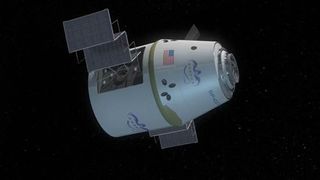SpaceX Prepares for Mid-March Launch to Space Station

Juggling flight delays and busy skies with the skill of seasoned air traffic controllers, International Space Station managers have approved the launch date for SpaceX's next cargo resupply mission for March 16.
Liftoff from Cape Canaveral's Complex 40 launch pad is set for 4:41 a.m. EDT (0841 GMT), the time when Earth's rotation brings the space station's flight path over the Space Coast, NASA announced last week.
SpaceX's Falcon 9 rocket and Dragon cargo carrier will make the company's third commercial logistics delivery to the space station under a $1.6 billion contract with NASA. The deal calls for 12 missions through 2016.
The Dragon spacecraft will chase the space station for two days, with final approach set for March 18 under the guidance of high-tech laser mapping sensors.
The outpost's crew, scheduled to be three-strong at the time of the Dragon capsule's arrival, will grapple the free-flying spacecraft with the space station's Canadian-built robot arm. The crane-like appendage will move the food- and experiment-toting Dragon to a parking port on the lab's Harmony module for a one-month stay. [The Rockets and Spaceships of SpaceX (Photos)]
The astronauts will unpack the Dragon spacecraft's pressurized cabin, about the size of a large walk-in closet, of several tons of supplies, including government, commercial and student experiments. Then the crew will reload the spaceship with an array of cargo tagged for return to Earth, including biological samples, equipment requiring repair, and other unnecessary gear.

Dragon's departure from the space station is tentatively set for April 17, with splashdown several hours later in the Pacific Ocean southwest of Southern California.
Get the Space.com Newsletter
Breaking space news, the latest updates on rocket launches, skywatching events and more!
Officials delayed the flight from a previous target launch date of Feb. 22, and poor weather prevented the Falcon 9 rocket's first stage from being delivered to Florida in time to be ready for a launch attempt in early March, according to a senior NASA space station official.
The Falcon 9's first and second stages, along with the Dragon spacecraft, are now at Cape Canaveral for launch processing, a SpaceX spokesperson said.
NASA expects a busy traffic pattern around the space station over the next few weeks, with the departure of an Orbital Sciences Corp. Cygnus resupply craft Feb. 18 after more than five weeks attached to the complex.
The Cygnus spacecraft will fall to Earth and dispose of trash and excess equipment with a destructive re-entry over the Pacific Ocean.
Cosmonauts Oleg Kotov and Sergey Ryazanskiy, joined by NASA astronaut Mike Hopkins, will leave the space station March 11 and return to a parachute-assisted landing in Kazakhstan, wrapping up 168 days in space.
Next on the manifest is the SpaceX cargo mission, followed by the March 25 launch and docking of three fresh crew members - Steve Swanson, Alexander Skvortsov and Oleg Artemyev.
Later in the spring, a Russian Progress cargo freighter will blast off to the space station April 9, another Orbital Sciences Cygnus spacecraft will deliver goods in early May, and another crew rotation is set for later in May.
Space station schedulers like to book time between the comings and goings of visiting vehicles to reduce the workload on the flight crew and ground teams.
Follow Stephen Clark on Twitter: @StephenClark1. You can follow Spaceflight Now on Twitter @SpaceflightNow and on Facebook. Copyright 2013 SpaceflightNow.com, all rights reserved.

Join our Space Forums to keep talking space on the latest missions, night sky and more! And if you have a news tip, correction or comment, let us know at: community@space.com.
Stephen Clark is the Editor of Spaceflight Now, a web-based publication dedicated to covering rocket launches, human spaceflight and exploration. He joined the Spaceflight Now team in 2009 and previously wrote as a senior reporter with the Daily Texan. You can follow Stephen's latest project at SpaceflightNow.com and on Twitter.

